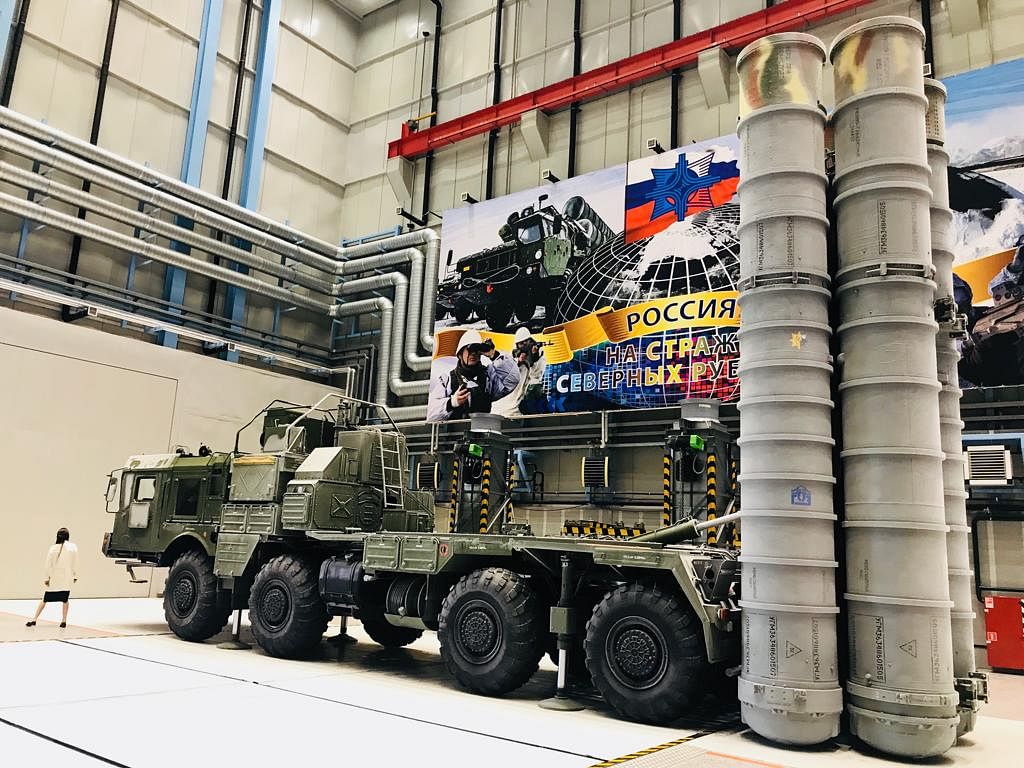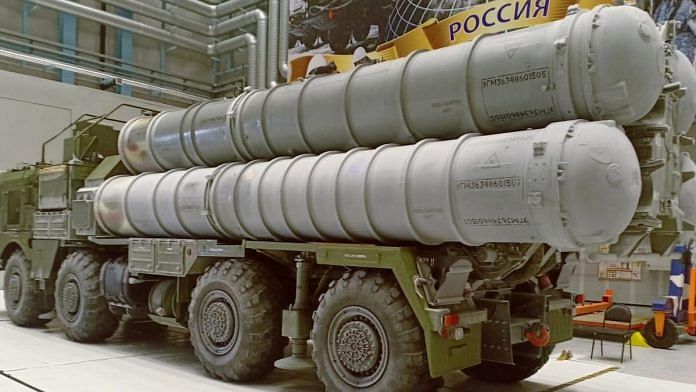St Petersburg: The production of the five regiments of S-400 Triumf multi-layered air defence system ordered by India for $5.2 billion will start soon and the first unit will be delivered by the end of 2020, a top Russian official said.
ThePrint had earlier reported both India and Russia have finally managed to agree to a payment mode to get around US sanctions.
The Russians have assured India that there will be no delay in the delivery of the S-400, which is considered to be one of the best air defence systems in the world. The S-400 will become India’s air defence umbrella and be the main pillar of the Indian Air Force’s (IAF) defence grid.
The S-400s are meant to be game-changer as they have been designed to knock down flying targets, including those equipped with stealth technologies, at a distance of about 400 km. The S-400 system is also capable of taking out ballistic missiles and hypersonic targets. Compared to its predecessor — the S-300 — the S-400 has a firing rate that is 2.5 times faster.

“There will be no delays in delivery. The production facility is equipped with state-of-art equipment and highly automated lines. The delivery will be done as per the schedule,” said Irina Volokitina, first deputy director at Almaz Antey North Western Regional Production Facility.
This reporter was among the first few selected journalists invited to visit the final assembly plant of the S-400.
Also read: Russia wants to build P75I submarines, says India needs better vessels than Scorpene
Three main advantages of S-400
Giving a tour of the sprawling production facility that was placed under American economic sanctions in July 2014 after Russia annexed the Ukrainian province of Crimea, Volokitina said an Indian Air Force team (IAF) would be coming next year to get trained on the system.
Stating the advantages of S-400s, she said: “First is the range of detection of any kind of aerial threat. It is twice as capable as all its rivals. Its range is up to 400 km and it can cover a height of up to 30 km. With a minimum range of 2 km and the minimum height of detection of 5 km, it is the best in the world.”
“The second advantage is the time of deployment for its full capability. The period of deployment is three times less than its nearest competitor. It has a whole array of systems. It has various kinds of missiles with different ranges and thus providing a multi-layered system. Not a single other system in the world has such a capability,” she said. “The third advantage is the competitive price,” Volokitina added.
Asked if the S-400 can really detect and take down stealth fighters like the American F-35, another senior official of the facility replied in affirmative.
“The S-400 is capable of detecting and destroying stealth targets. But, due to objective reasons, there has never been a situation where a stealth aircraft has flown within the range of the S-400,” he added.
“We have worked out these scenarios and are absolutely sure that it can indeed shoot down a stealth aircraft. We also know from the western media that their governments acknowledge those capabilities,” the officer said.
Tour of the production facility
The Obukhovskiy factory of the North Western Regional centre of Almaz Antey, situated just on the borders of St Petersburg, is 150 years old and used to make canons, mines and ammunition for the Russian military.
It slowly transformed into the assembly line of S-400 and is surrounded by a host of other factories. Almaz Antey was formed 15 years ago and has a total of 64 firms operating under it.
The tour organised for ThePrint focused on the state-of-the-art testing centre, which has been fine-tuned to also meet the Indian situations.
The site for climatic testing includes specially-shielded rooms, which produce temperatures from -70 degree to over 100 degrees. These rooms are fitted with high resolution cameras.
In addition to it and the rain and moisture centres, the facility also has a dust-resistant testing centre. “India has a lot of dust and extreme heat. The systems of S-400 undergo such tests to ensure that the systems work no matter what the climatic conditions are,” the chief of the testing centre said.
ThePrint was also shown various systems of the S-400 getting tested, including the launchers that had to undergo a grueling -50 degree climatic condition.
Since the crew also have to undergo similar climatic conditions, one of the testing personnel was also in the mobile launcher to see if the operators too can keep themselves warm.
Each S-400 battery comprises long-range radar, a command post vehicle, target acquisition radar and two battalions of launchers — each battalion has eight. Each launcher has four tubes.
The S-400 can be armed with four different types of missiles with ranges of 400 km, 250 km, 120 km and 40 km. The Long Range (LR) radar can track more than 100 flying objects simultaneously while being able to engage a dozen targets.
Each component of the system — the radars, the command post vehicles and the launchers — is mounted on multi-axle, multi-wheel Ural carriers that can move on uneven terrains. This mobility makes the batteries difficult to detect because they can keep changing locations, besides expanding the missile engagement zone (MEZ).
This reporter is visiting Russia as a guest of United Shipbuilding Corporation.
Also read: Payment hurdle fixed, Russia to build two stealth frigates for Indian Navy




Buy whatever you guys can, 27th Feb will happen as many times as you attempt 26th Feb.
There are always countermeasures and counter-countermeasures. You deploy S400s, PAF will come with a different reply and then you will run again to Russians or Israelis.
Wonderful. 27th February would not have happened if the S 400 had been deployed.
It’s not like India had no air defence system actively operating that day! Might not be as potent as triumfs, but there certainly were .
One wonders then, why didn’t we use those systems to shoot down approaching jf17s and f16s instead of sending our migs to chase them back to deep inside Pak. Even more baffling is that we (even by mistake) used air defence to shoot down one of our own heli ! Why ??
Realising that our IAF certainly is more professional if only they could provide an explainer to events of those days.